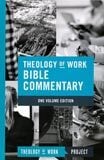Example - Insights on Teaching Old Testament from Curricular Workshops
Seminary Curriculum / Produced by TOW Project
My previous article provided an overview of the relevance of some broad Old Testament themes for exploring faith and work issues. This article, part two, describes how our discussions with faculty moved beyond these broad themes to identify ways that particular OT books and passages might help to address specific issues.
Reading the Bible with Workplace Eyes Is Not Our Default Setting
It was surprising how often our discussions were about seeing new things in old, familiar texts, or at least viewing these texts from a different angle. For example, we discussed how the Song of Songs is one of the books in which the significance of work has largely been ignored by commentators, even though a lot of themes developed there are derived from the experience of a couple who are working to establish a family vineyard business. I have to admit that even as a regular preacher and Bible teacher myself, I was ignorant about this until I worked on the Theology of Work Bible Commentary, looking at the Song of Songs and more than 800 other Bible passages that have something to say about work and the way we approach it. Students need help to address this hermeneutical challenge.
Immigration, Border Crossings, Work and Welfare, Sexual Harassment…
The book of Ruth is a wonderful example of an OT book that addresses a variety of issues that are still contemporary challenges. Where else in the Bible do you find, in just four short chapters, stories of all these important issues?
- Border crossings to escape famine
- Cross-cultural marriages and inter-religious relationships
- Vulnerable widows struggling with life and faith in the face of death
- An immigrant among God’s people
- A solution to poverty that transcends welfare
- Protection against workplace sexual harassment
- Love, marriage and the astute management of complex family relationships and delicate business negotiations
Some very condensed examples of how these themes might be developed, including assignment possibilities, can be found here, and also in the two-part article I co-wrote for the ON newsletter. Further observations about Ruth and work can also be found in the paper on women and work that is introduced under the next heading.
Women and Work in the OT
The work of women in the OT – just like the work of men – includes paid and unpaid work, work in the home and work in the marketplace, the work of slaves and national leaders, admired work and despised work. The article Women Workers in the OT looks at the examples of ten women whose experiences at work express this diversity. These women include Eve, Shiphrah and Puah, Rahab, Deborah, Ruth, Abigail, Huldah, Esther and Lady Wisdom of Proberbs. Fuller Seminary’s De Pree Center has recently published a leading resource on this topic.
Leadership and Wisdom at Work
Hours could be spent discussing what we can learn from the examples of the OT kings and judges about effective and ineffective leadership (David, for example). And about how leadership so often is corrupting and how leaders need to be held accountable (see the roles Nathan and Abigail played in confronting David).
What does it mean to be a wise leader, or for that matter a wise worker, today? What does wisdom mean at work? How does OT wisdom relate to NT wisdom?
Work and Rest
There is a lot of talk about the importance of work-life balance today. In our discussions, theological educators expressed some discomfort about talking as if work and life fit into different categories. In general, we are trying to see work as an integrated part of life and recognise the importance of the various dimensions of our whole life’s work (including paid and unpaid responsibilities). But understanding the importance of biblical rhythms of work and rest remains a challenge for a generation in which identity and status have become so closely tied to professional roles, and busyness and productivity have become virtues we so admire that we almost feel guilty even thinking about resting. Any exploration of these themes inevitably draws heavily on the Genesis account of creation and the discussions in Exodus 20 and Deuteronomy 5 of the fourth commandment (see also the paper Balancing Rhythms of Work and Rest).
What is the Ultimate Meaning of Work?
The beginnings of human work are unfolded in Genesis 1 and 2. The mixture of our fulfilling, frustrating and futile post-fall experiences at work are described in Ecclesiastes 2 and 3. But we also find in the OT a glimpse of the ultimate meaning of work in the visions that conclude the book of Isaiah. In Isaiah chapters 60-66, Israel’s future hope as the New Creation is pictured as that time when people will actually receive the things they work for, because “they shall not labor in vain” (Isaiah 65:23). Israel’s sorrow will be turned into joy. One of the dominant motifs of this coming joy is the enjoyment of the work of their own hands. Here is a glimpse of the end of history as something connected to our daily work and our deepest longings that is much richer and better than those more common, but I think much less satisfying, conceptions of our end either as passive eternal spectators or in an exhausting eternal worship service. Isaiah’s vision provides us with the glimpse of a hope that is worth looking forward to – and working towards.






